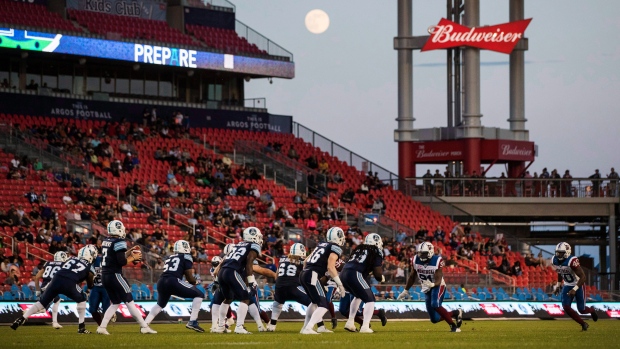Jul 9, 2021
Questions surrounding big markets loom after CFL-XFL fallout
The 2021 CFL season represents a long-awaited return for players, coaches and fans. But things moving back to normal in the short term doesn’t mean the league’s problems are all behind it, Dave Naylor writes.
By Dave Naylor

We interrupt this joyous return to the field in Canadian Football for a reality check about the future of the league beyond this season.
As most are aware, the CFL announced this week that it’s no longer in talks about collaboration with the XFL, meaning the league will plot its way into the future as we’ve always known in it – nine teams in Canada, playing three-down football, guaranteeing 21 Canadians on every team.
And a business model that’s as traditional as it gets.
All of which is reason for celebration for many, especially those who believe that the CFL’s traditional qualities give it a unique flavour in the vast and ever-expanding world of professional sports.
Heck, it was even cause for one CFL team (Edmonton) to issue a celebratory news release that might as well have read “Ding, dong, The Witch is dead.”
So into the future the CFL goes, pretty much as we’ve always known it.
The only problem with that is that the CFL business model – which is fundamental to its existence -- hasn’t worked very well of late in Vancouver, Montreal and especially Toronto.
And unless the league comes up with a way to solve that, or ensure ownership in those cities is willing to subsidize teams in perpetuity, then there’s going to a crisis. And quite possibly, a big one.
Objectively, the ownership situation in all three of those markets is such that it begs questions about the future.
The B.C. Lions were owned by David Braley for more than 23 years when the Ontario businessman passed away in October of 2020, leaving the team in the hands of his estate.
Braley supported the Lions through some lean years, with his own money and that from the many Grey Cups he hosted, as owner in B.C. and, for a time, in Toronto.
But he leaves the franchise on a low in terms of popularity and profitability. The Lions didn’t draw 20,000 fans to a single game last season.
And the brand is struggling to engage younger fans, as it does elsewhere in the country.
There is said to be multiple groups interested in purchasing the team, but the devil here is in the details. Under what terms?
The next owner of the B.C. Lions has to be prepared to spend, at least for a while.
Which is what various owners of the Toronto Argonauts have been doing since the late 1980s.
Maple Leaf Sports and Entertainment believed they could at least minimize those losses with their might and a team playing out of fan-friendly BMO Field. But the country’s largest sport entertainment company hasn’t been able to breathe new life in the Argo brand, and there’s no sign of that changing.
MLSE is in the business of generating revenues and growing franchise values, neither of which they’ve been able to do with the Argonauts.
So is it any surprise that MLSE is known to have been the largest supporter of collaboration with the XFL? Or that their belief in the current CFL business model is marginal at best, and just might be nonexistent?
It’s understandable why they might have believed that a risk on the XFL was better than certainty in the CFL and why Montreal and B.C. were among the more supportive clubs in this respect as well.
The question now becomes, what is MLSE’s wherewithal to remain owners of the Argonauts, now that the CFL is going to stay the CFL? That may be the most critical question for the future of the league, since there aren’t going to be long list of potential buyers for this team if MLSE decides it’s had enough.
What effect all of that might have on the situation in Montreal is another interesting question.
Montreal owners Gary Stern and Sid Spiegal were brought into the league in January of 2020, at urging of MLSE executive Dale Lastman, who is also the CFL’s chairman of the board.
If Lastman and MLSE take their ball and go home, do Stern and Spiegal stay? It’s a matter that seems utterly impossible to predict.
There is still the hope that it might not come to all of this, that revenues through partnerships in legalized gambling might change the league’s business prospects, which along with belt-tightening and revenue sharing could convince every owner to stay the course, and attract new and committed ownership to B.C.
It is the nature of the CFL, with its big cities and small, its public ownership and private, that teams tend to see what’s best for the league from very different perspectives.
Which historically has meant tremendous difficulty getting everyone to share the same vision for the league.
This most recent chapter in CFL history is no different.
